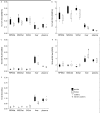Lipid classes in adipose tissues and liver differ between Shetland ponies and Warmblood horses
- PMID: 30897169
- PMCID: PMC6428305
- DOI: 10.1371/journal.pone.0207568
Lipid classes in adipose tissues and liver differ between Shetland ponies and Warmblood horses
Abstract
Fatty acids, as key components of cellular membranes and complex lipids, may play a central role in endocrine signalling and the function of adipose tissue and liver. Thus, the lipid fatty acid composition may play a role in health status in the equine. This study aimed to investigate the fatty acid composition of different tissues and liver lipid classes by comparing Warmblood horses and Shetland ponies under defined conditions. We hypothesized that ponies show different lipid patterns than horses in adipose tissue, liver and plasma. Six Warmblood horses and six Shetland ponies were housed and fed under identical conditions. Tissue and blood sampling were performed following a standardized protocol. A one-step lipid extraction, methylation and trans-esterification method with subsequent gas chromatography was used to analyse the total lipid content and fatty acid profile of retroperitoneal, mesocolon and subcutaneous adipose tissue, liver and plasma. Fatty acids were grouped according to their degree of saturation and their conjugated double bond into the respective lipid classes. In the adipose tissues, saturated fatty acids (SFAs) and n-9 monounsaturated fatty acids (n-9 MUFAs) were most present in ponies and horses. N-6 polyunsaturated fatty acids (n-6 PUFAs), followed by SFAs, were most frequently found in liver tissue and plasma in all animals. Horses, in comparison to ponies, had significantly higher n-6 PUFA levels in all tissues and plasma. In liver tissue, horses had significantly lower hepatic iso-branched-chain fatty acids (iso-BCFAs) than ponies. The hepatic fatty acid composition of selected lipid classes was different between horses and ponies. In the polar PL fraction, horses had low n-9 MUFA and n-3 PUFA contents but higher n-6 PUFA contents than ponies. Furthermore, iso-BCFAs are absent in several hepatic lipid fractions of horses but not ponies. The differences in fatty acid lipid classes between horses and ponies provide key information on the species- and location-specific regulation of FA metabolism, thus affecting health status such as inflammatory responses.
Conflict of interest statement
The authors have declared that no competing interests exist.
Figures

Similar articles
-
Effect of dietary conjugated linoleic acids on the distribution of fatty acids in serum lipoprotein fractions and different tissues of growing pigs.J Anim Physiol Anim Nutr (Berl). 2002 Oct;86(9-10):313-25. doi: 10.1046/j.1439-0396.2002.00385.x. J Anim Physiol Anim Nutr (Berl). 2002. PMID: 12452973
-
The influence of equine body weight gain on inflammatory cytokine expressions of adipose tissue in response to endotoxin challenge.Acta Vet Scand. 2020 Apr 22;62(1):17. doi: 10.1186/s13028-020-00515-5. Acta Vet Scand. 2020. PMID: 32321549 Free PMC article.
-
Positional analysis of triacylglycerols from bovine adipose tissue lipids varying in degree of unsaturation.Lipids. 1998 Feb;33(2):197-207. doi: 10.1007/s11745-998-0196-8. Lipids. 1998. PMID: 9507242
-
Effects of exercise on the fatty-acid composition of blood and tissue lipids.Sports Med. 2004;34(15):1051-76. doi: 10.2165/00007256-200434150-00004. Sports Med. 2004. PMID: 15575795 Review.
-
[Minor fatty acids of biological fluids of urogenital organs and their significance in the diagnosis of inflammatory processes].Zh Mikrobiol Epidemiol Immunobiol. 2003 Mar-Apr;(2):92-101. Zh Mikrobiol Epidemiol Immunobiol. 2003. PMID: 12886617 Review. Russian.
Cited by
-
The Bovine Hepatic Cell Line BFH12 as a Possible Model for Hepatosteatosis in Dairy Cows.Front Vet Sci. 2022 Mar 11;9:840202. doi: 10.3389/fvets.2022.840202. eCollection 2022. Front Vet Sci. 2022. PMID: 35359674 Free PMC article.
-
Fatty Acid Content and Composition of the Yakutian Horses and Their Main Food Source: Living in Extreme Winter Conditions.Biomolecules. 2020 Feb 17;10(2):315. doi: 10.3390/biom10020315. Biomolecules. 2020. PMID: 32079257 Free PMC article.
-
Qualitative and Quantitative Changes in Total Lipid Concentration and Lipid Fractions in Liver Tissue of Periparturient German Holstein Dairy Cows of Two Age Groups.Front Vet Sci. 2022 Mar 15;9:814808. doi: 10.3389/fvets.2022.814808. eCollection 2022. Front Vet Sci. 2022. PMID: 35372546 Free PMC article.
-
The Equine Faecal Microbiota of Healthy Horses and Ponies in The Netherlands: Impact of Host and Environmental Factors.Animals (Basel). 2021 Jun 12;11(6):1762. doi: 10.3390/ani11061762. Animals (Basel). 2021. PMID: 34204691 Free PMC article.
-
Markers of Hepatic Insulin Clearance and Their Association With Steatosis in Hyperinsulinaemic Horses.J Vet Intern Med. 2025 Jul-Aug;39(4):e70143. doi: 10.1111/jvim.70143. J Vet Intern Med. 2025. PMID: 40476757 Free PMC article.
References
-
- Bauer JE, Ransone WD. Fatty acid composition of serum lipids in fasting ponies. Lipids. 1983;18: 397–401. - PubMed
-
- Watson TDG, Burns L, Love S, Packard CJ, Shepherd J. The isolation, characterisation and quantification of the equine plasma lipoproteins. Equine Vet J. 1991;23: 353–359. - PubMed
-
- Asadi F, Asadian P, Shahriari A, Pourkabir M, Kazemi A. Serum lipid and lipoprotein patterns of Iranian horses. Rev Sci Tech. 2011;30: 955–960. - PubMed
-
- Nazifi S, Saeb M, Rategh S, Khojandi A. Serum lipids and lipoproteins in clinically healthy Caspian miniature horses. Veterinarski Arhiv. 2005;75: 175–182.
-
- Straub R, Petitjean J, Tschudi P. Serumlipide und lipoproteide bei gesunden Equiden. Schweizer Archiv fur Tierheilkunde. 1977;119: 92–101. - PubMed
Publication types
MeSH terms
Substances
LinkOut - more resources
Full Text Sources

